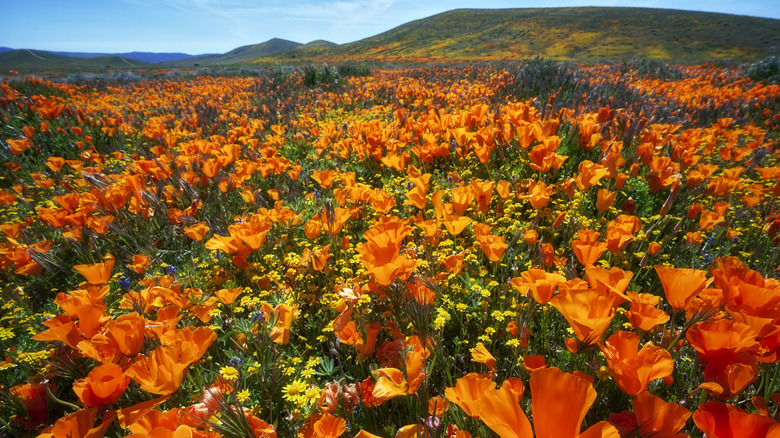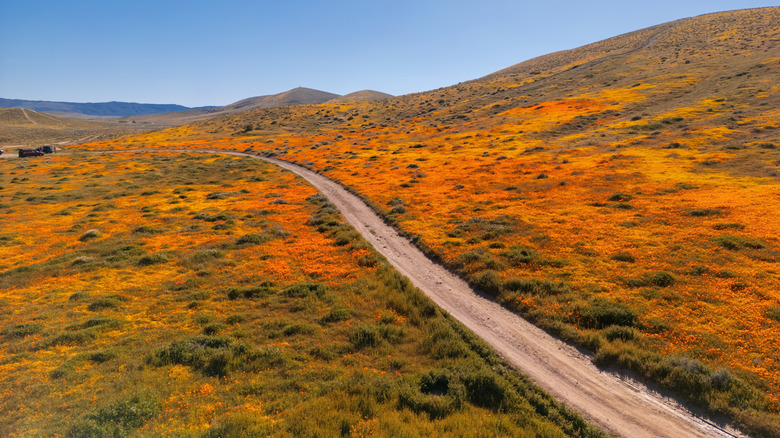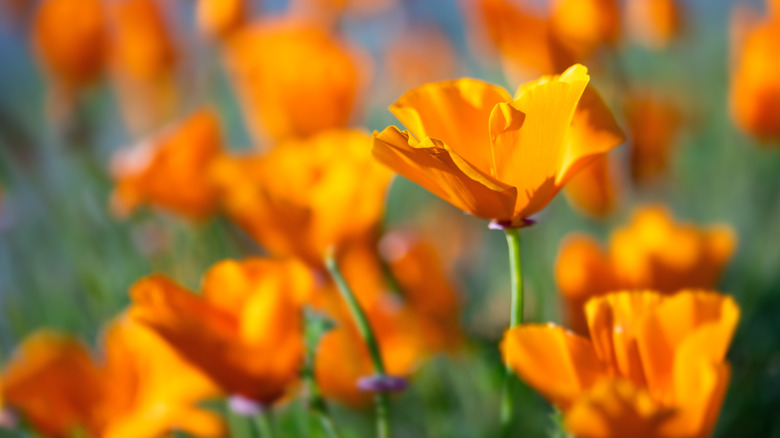One Of California's Most Consistent Poppy-Bearing Areas Is An Impossibly Colorful State Park In Los Angeles
The best part of a California spring is when flowers bloom, sweeping up through the south into the central coast plains. Depending on how the rains and winds were during the preceding winter, the state's iconic wildflowers might start blooming anywhere from late February onward, and every 10 to 15 years or so the conditions may be right for a superbloom — a rare phenomenon that has people all over Los Angeles looking for the best destinations to see these vibrant flower fields that are even visible from space.
It's no wonder that California claims the golden poppy as its official state flower, as it vividly carpets the fields and catches eyes all season (though the poppies' duration, vibrance, and even potency can vary annually). One of the most reliable places to experience poppies in Southern California is Antelope Valley California Poppy Reserve State Park, where you can stroll through colorful fields and spot native wildlife.
Los Angeles is one of those sprawling places where you can start your day in the heart of Mid-City, an urban neighborhood with street murals, vintage movie theaters, and restaurants, then drive out to Antelope Valley an hour and a half north to see the golden poppies, and get back to town in time to hike up to the Griffith Park Observatory and stargaze. The diversity of culture and nature in this Mediterranean climate has drawn countless transplants and visitors to the state. The entrance fee to the park is $10 per vehicle, with discounts available for seniors and DPR card holders, as of this writing.
Antelope Valley is a goldmine of flora and fauna
Antelope Valley has eight miles of gentle walking trails, including a small paved section for wheelchair accessibility, and benches throughout. Of course, golden poppies aren't the only wildflowers that make up California's delightful spring blooms. A spread of flora – including lupine, fiddlenecks, and juniper — is backdropped throughout the reserve by the San Gabriel Mountains and the Tehachapi Mountains. Despite human traffic, there's plenty of wildlife to observe here: Rocky Mountain mule deer, mountain quail, hawks, squirrels, and leopard frogs call the Antelope Valley home. Coyotes and bobcats roam, too, though it's less likely you'll see them during the daytime. Watch out for gopher snakes and rattlesnakes: As the months warm up, it can be common to see snakes on hiking trails.
During wildflower season, you can also visit the Jane S. Pinheiro Interpretive Center — a sustainably-designed building that utilizes solar and wind power — where there's poppy-themed artwork on display from local artists including Jane Pinheiro, for whom the center's named. Pinheiro was an artist and conservationist nicknamed "The Great Poppy Lady." She fell in love with painting the poppies, became a self-taught botanist, and advocated for the establishment of the Antelope Valley Poppy Preserve to help maintain and protect this natural resource.
Keep in mind a few rules when admiring the poppies to ensure these natural treasures stay protected. Stay on the trail, and don't pick the flowers. During one superbloom, a social media trend saw people venturing off-trail into the fields for photoshoots. They were quickly criticized for crushing blooms and seeds, risking future seasons. At least one park even closed temporarily. Follow any posted restrictions and closures to ensure your safety as well as the ecosystem's.
The Golden Poppy is a California state treasure
Golden poppies have brilliant, orange-colored petals with green, feathery leaves. They are self-seeding, which means they replicate easily, contributing to the vast carpets of blooms that can be found across the California plains. Golden poppies are drought-resistant and deer-resistant, making them hardy plants that thrive with lots of sunshine even along the side of highways. Indigenous tribes across California once used poppies in tinctures for pain relief and sedatives. While some poppies are considered toxic if ingested, the California poppy is considered mild and some even use it as an edible medicinal plant. It's certainly not your opium poppy, made famous by The Wizard of Oz!
If you want to stay overnight near Antelope Valley, you cannot camp in the park; however, you can use a camping receipt from another California state park, like Saddleback Butte State Park, to gain free entry to Antelope Valley. Alternatively, there are private campgrounds nearby, like the Magic Portal Stargazer's Retreat, an outdoor camping/RV space about four miles from the Antelope Valley Poppy Reserve. The nearest town is Lancaster, about 15 miles west, which has a number of motels.
If you're close to the West Coast but not close enough to Los Angeles, you can still catch poppies elsewhere in the state. The Carizzo Plain National Monument in California's central valley is considered a pristine spot, as is the Point Reyes National Seashore up in Northern California's Marin County. Consider hiking one of California's prettiest coastal trails in Headlands State Park near Morro Bay, with cliffside views of the Pacific Ocean and path-side poppies during the season. It's just under 4 hours from San Francisco, and only about 30-40 minutes from San Luis Obispo.


